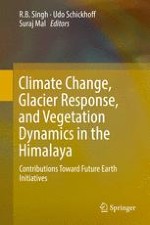2016 | OriginalPaper | Buchkapitel
4. Climate Change and Hydrological Responses in Himalayan Basins, Nepal
verfasst von : Tirtha Raj Adhikari, Lochan Prasad Devkota
Erschienen in: Climate Change, Glacier Response, and Vegetation Dynamics in the Himalaya
Aktivieren Sie unsere intelligente Suche, um passende Fachinhalte oder Patente zu finden.
Wählen Sie Textabschnitte aus um mit Künstlicher Intelligenz passenden Patente zu finden. powered by
Markieren Sie Textabschnitte, um KI-gestützt weitere passende Inhalte zu finden. powered by
